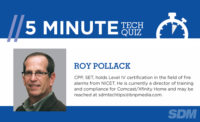Life safety systems are required to meet strict compliance standards in schools, hotels, hospitals, offices, and public spaces of all types. These systems are regularly inspected to assure that they meet NFPA code, and are tested to ensure proper operation. When a system problem is detected, it may lead to a shutdown of the facility, which triggers a number of challenges for facility management and occupants alike.
It’s most important to safeguard the operation of life safety systems by properly installing and maintaining products from reputable manufacturers. But the cause of system outages and failures can often originate from outside the life safety system itself. For example, a large vacation resort in Florida recently paid $260,000 to repair their fire alarm system due to a random power surge from the grid, as there weren’t any surge protection solutions in place. The resort also had to pay for a fire watch that cost $53,000 over a 17-day period when the alarm was down. As part of the repair to get the system up and running, the facility installed advanced surge protection solutions to cover the entire system for approximately $8,000. Had this equipment been in place, damage to the fire alarm system may have been completely avoided.
Power Surges Are Daily Dangers
A common misconception about power surges is that electrical and electronic devices are only at risk during thunderstorms. According to the Insurance Institute for Business and Home Safety, lightning strikes account for just 2 percent of all surge-related damage. That means that 98 percent of the damage is done by the hundreds of smaller power surges that are mostly unnoticed every day. Building managers may believe that because some fire panels have built-in surge protection that no additional protection is necessary. The truth is that any built-in surge protection is not sufficient to protect the system from all power surge dangers.
Let’s consider a typical fire alarm system that is organized around a central control panel, usually called a fire alarm control panel (FACP). The FACP is the “brain” of the system — monitoring sensor inputs, controlling alarms and outputs to other systems, and relaying information. Because it is the core of the system — and can be damaged by power surges — its 120V power should be equipped with a surge protection device.
While protecting the input power is necessary to protect the FACP, it is not sufficient. There are other electrical pathways into the unit that can expose it to potentially damaging power surges, causing the system to fail over time due to small surges, or all at once in the event of a dramatic surge or a lightning strike anywhere near the facility.
One type of potential pathway is any electrical connection that passes outdoors. For example, telephone lines are often connected to the FACP to enable management notifications and to summon emergency response automatically during alarm conditions. Because they are electrical conductors that pass outside the facility, they are vulnerable to electrical disturbances — including accidental contact with power lines, or induced currents from lightning strikes that could be miles away. Any such power surge can be passed into the FACP and cause damage. The same caution holds true for signaling line circuits (SLCs) that connect multiple buildings together and are located outdoors.
Indoor devices can also provide alternative pathways for power surges to enter the FACP. In particular, powered notification devices such as audible alarms and visual emergency signals such as horns, buzzers and flashing lights are connected to the FACP with notification alarm circuits (NACs).
Why Protection Matters
When protecting life safety systems, local fire codes set minimum protection standards, and are not designed or intended to protect the systems themselves from potential damage. Protecting these systems with surge suppression solutions is certainly necessary to ensure reliable operation and overall safety. Consult with reputable suppliers of surge suppression technology designed for professional security systems to assess your customers’ needs and determine the best levels of protection required for your specific installation. — Contributed by Jason Klein, national sales manager, DITEK Surge Protection






